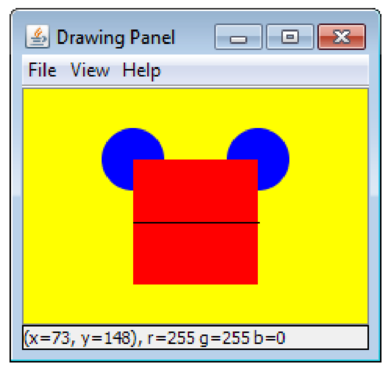
Draw the given picture
- Import the required packages.
- Create the class “Micky”,
- Define the “main()” method,
- Construct the “DrawingPanel” object.
- Set the background for the panel.
- Create “Graphics” object and call the method “getGrphics()”.
- Set the color as “BLUE”.
- Fill the oval shapes for the given range with color “BLUE”.
- Set the color as “RED”.
- Fill the rectangle shape for the specified range with color “RED”.
- Set the color as “BLACK”.
- Draw the line with color “BLACK”.
- Define the “main()” method,
This program is to use the “DrawingPanel” to draw the given picture.
Explanation of Solution
Program:
File name: “Micky.java”
//Import necessary packages
import java.awt.Color;
import java.awt.Graphics;
//Create a class
public class Micky
{
//Define the main() method
public static void main(String[] args)
{
//Create DrawingPanel object
DrawingPanel p = new DrawingPanel(220, 150);
//Set the background
p.setBackground(Color.YELLOW);
//Create Graphics object
Graphics g1 = p.getGraphics();
//Set the color as "BLUE"
g1.setColor(Color.BLUE);
//Fill the oval shape in a range with that color
g1.fillOval(50, 25, 40, 40);
g1.fillOval(130, 25, 40, 40);
//Set the color as "RED"
g1.setColor(Color.RED);
//Fill the rectangle shape with the given range as "RED"
g1.fillRect(70, 45, 80, 80);
//Set the color as "BLACK"
g1.setColor(Color.BLACK);
//Draw the line with "BLACK" color
g1.drawLine(70, 85, 150, 85);
}
}
Screenshot of output:

Want to see more full solutions like this?
- Please solve and answer the questions correctly please. Thank you!!arrow_forwardConsidering the TM example of binary sum ( see attached)do the step-by-step of execution for the binary numbers 1101 and 11. Feel free to use the Formal Language Editor Tool to execute it; Write it down the current state of the tape (including the head position) and indicate the current state of the TM at each step.arrow_forwardI need help on inculding additonal code where I can can do the opposite code of MatLab, where the function of t that I enter becomes the result of F(t), in other words, turning the time-domain f(t) into the frequency-domain function F(s):arrow_forward
 Database System ConceptsComputer ScienceISBN:9780078022159Author:Abraham Silberschatz Professor, Henry F. Korth, S. SudarshanPublisher:McGraw-Hill Education
Database System ConceptsComputer ScienceISBN:9780078022159Author:Abraham Silberschatz Professor, Henry F. Korth, S. SudarshanPublisher:McGraw-Hill Education Starting Out with Python (4th Edition)Computer ScienceISBN:9780134444321Author:Tony GaddisPublisher:PEARSON
Starting Out with Python (4th Edition)Computer ScienceISBN:9780134444321Author:Tony GaddisPublisher:PEARSON Digital Fundamentals (11th Edition)Computer ScienceISBN:9780132737968Author:Thomas L. FloydPublisher:PEARSON
Digital Fundamentals (11th Edition)Computer ScienceISBN:9780132737968Author:Thomas L. FloydPublisher:PEARSON C How to Program (8th Edition)Computer ScienceISBN:9780133976892Author:Paul J. Deitel, Harvey DeitelPublisher:PEARSON
C How to Program (8th Edition)Computer ScienceISBN:9780133976892Author:Paul J. Deitel, Harvey DeitelPublisher:PEARSON Database Systems: Design, Implementation, & Manag...Computer ScienceISBN:9781337627900Author:Carlos Coronel, Steven MorrisPublisher:Cengage Learning
Database Systems: Design, Implementation, & Manag...Computer ScienceISBN:9781337627900Author:Carlos Coronel, Steven MorrisPublisher:Cengage Learning Programmable Logic ControllersComputer ScienceISBN:9780073373843Author:Frank D. PetruzellaPublisher:McGraw-Hill Education
Programmable Logic ControllersComputer ScienceISBN:9780073373843Author:Frank D. PetruzellaPublisher:McGraw-Hill Education





